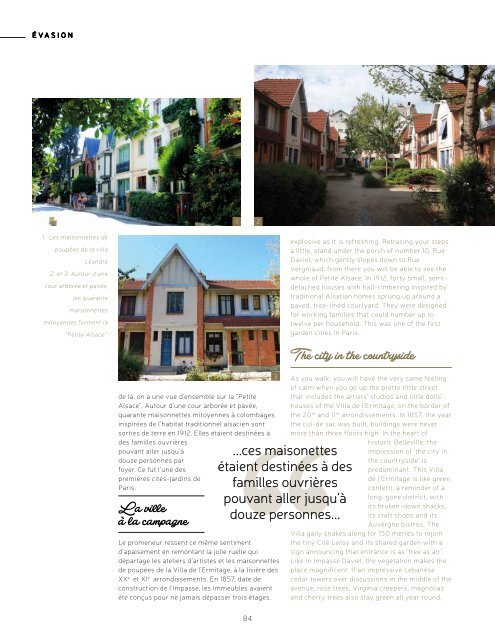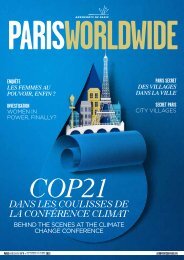You also want an ePaper? Increase the reach of your titles
YUMPU automatically turns print PDFs into web optimized ePapers that Google loves.
ÉVASION<br />
1<br />
2<br />
1. Les maisonnettes de<br />
poupées de la villa<br />
Léandre<br />
2. et 3. Autour d’une<br />
cour arborée et pavée,<br />
les quarante<br />
maisonnettes<br />
mitoyennes forment la<br />
“Petite Alsace”.<br />
explosive as it is refreshing. Retracing your steps<br />
a little, stand under the porch of number 10, Rue<br />
Daviel, which gently slopes down to Rue<br />
Vergniaud; from there you will be able to see the<br />
whole of Petite Alsace. In 1912, forty small, semidetached<br />
houses with half-timbering inspired by<br />
traditional Alsatian homes sprung up around a<br />
paved, tree-lined courtyard. They were designed<br />
for working families that could number up to<br />
twelve per household. This was one of the first<br />
garden cities in Paris.<br />
The city in the countryside<br />
de là, on a une vue d’ensemble sur la “Petite<br />
Alsace”. Autour d’une cour arborée et pavée,<br />
quarante maisonnettes mitoyennes à colombages<br />
inspirées de l’habitat traditionnel alsacien sont<br />
sorties de terre en 1912. Elles étaient destinées à<br />
des familles ouvrières<br />
pouvant aller jusqu’à<br />
douze personnes par<br />
foyer. Ce fut l’une des<br />
premières cités-jardins de<br />
Paris.<br />
La ville<br />
à la campagne<br />
Le promeneur ressent ce même sentiment<br />
d’apaisement en remontant la jolie ruelle qui<br />
départage les ateliers d’artistes et les maisonnettes<br />
de poupées de la Villa de l’Ermitage, à la lisière des<br />
XX e et XI e arrondissements. En 1857, date de<br />
construction de l’impasse, les immeubles avaient<br />
été conçus pour ne jamais dépasser trois étages.<br />
3<br />
...ces maisonettes<br />
étaient destinées à des<br />
familles ouvrières<br />
pouvant aller jusqu’à<br />
douze personnes...<br />
As you walk, you will have the very same feeling<br />
of calm when you go up the pretty little street<br />
that includes the artists’ studios and little dolls’<br />
houses of the Villa de l’Ermitage, on the border of<br />
the 20 th and 11 th arrondissements. In 1857, the year<br />
the cul-de sac was built, buildings were never<br />
more than three floors high. In the heart of<br />
historic Belleville, the<br />
impression of ‘the city in<br />
the countryside’ is<br />
predominant. This Villa<br />
de l’Ermitage is like green<br />
confetti, a reminder of a<br />
long-gone district, with<br />
its broken-down shacks,<br />
its craft shops and its<br />
Auvergne bistros. The<br />
Villa gaily snakes along for 150 metres to rejoin<br />
the tiny Cité Leroy and its shared garden with a<br />
sign announcing that entrance is as ‘free as air’.<br />
Like in Impasse Daviel, the vegetation makes the<br />
place magnificent. If an impressive Lebanese<br />
cedar towers over discussions in the middle of the<br />
avenue, rose trees, Virginia creepers, magnolias<br />
and cherry trees also stay green all year round.<br />
84
















